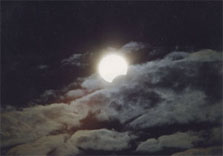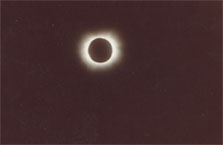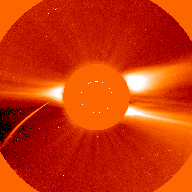|
|
|
A BRIEF PRIMER ON SOLAR ECLIPSES
|
|
|
|
Solar eclipses occur when the moon passes between the earth and the sun, thus blocking out the light of the sun for some portions of the earth's surface. Consequently, solar eclipses can only occur during the phase of the moon that we call "new moon." We thus might expect eclipses to take place every month, except for the fact that the moon's orbit is tilted about 5 degrees with respect to the earth's orbit. Eclipses can only take place when new moon coincides with the moon's crossing the plane of the earth's orbit, and on the average this occurs about once every six months. |
|
|
|
PARTIAL ECLIPSES
|
|
 |
|
|
|
Partial eclipses occur when the moon only covers up a portion of the sun. These can range from very tiny eclipses where only a small portion of the sun is covered, up to the eclipses where almost the entire sun is obscured. Different regions of the earth's surface will see different amounts of the sun covered up during a partial eclipse.
There are four partial solar eclipses during the year 2000: on February 5, over Antarctica; on July 1, over the south Pacific and the southern tip of South America; on July 31, over the Arctic Ocean, Alaska, northern Siberia, and northwestern Canada; and December 25, over the United States, Mexico, and most of Canada.
|
|
|
|
A typical partial solar eclipse. Photo by Alan Hale |
|
|
During some eclipses the moon passes directly in front of the sun as seen from a narrow strip, or "path," along the earth's surface. Sky-watchers located within this path -- usually a couple of hundred miles wide -- will see either a total eclipse or an annular eclipse, depending upon how far the moon is away from the earth. (The moon's orbit around the earth is not a perfect circle, and thus is farther from the earth than at other times.) Sky-watchers who are not located within the part but close to it will witness a partial eclipse; the closer they are to the path, the larger will be the partial eclipse. "Totality" or "annularity" will only last at most a few minutes from any particular location within the path; this will be preceded by an ever-increasing partial eclipse for approximately 1.5 hours prior to the main event itself, and followed by a steadily decreasing partial eclipse for 1.5 hours afterward. |
|
|
|
ANNULAR ECLIPSES
|
|
|
|
 |
|
|
| Annular eclipses occur when the moon is relatively far away from the earth, and thus does not appear large enough to cover up the entire sun. A thin ring, or "annulus" of sunlight will remain around the moon.
The next annular solar eclipse takes place on December 14, 2001, and can be seen across the central Pacific Ocean and along the border between Nicaragua and Costa Rica. The associated partial eclipse can be seen from the United States, Mexico, Central America, and the northwestern portion of South America.
|
|
|
Annular solar eclipse (at sunset) from San Diego, California, January 4, 1992. Photo by Alan Hale |
|
|
|
TOTAL ECLIPSES
|
|
 |
|
|
|
Total eclipses, which occur when the moon is relatively near to the earth, are by far the most spectacular. The moon covers up the sun entirely, except for the corona, the sun's hot but very tenuous outer atmosphere. For the few minutes of totality day is briefly turned into night, and the brighter planets and stars become visible.
Following the August 11, 1999 eclipse, the next total solar eclipse takes place on June 21, 2001. Totality will be visible from the south Atlantic Ocean and the African nations of Angola, Zambia, Zimbabwe and Mozambique, and the island of Madagascar. The partial eclipse will be visible from eastern South America and central and southern Africa.
|
|
|
|
Total solar eclipse from Boissevain, Manitoba, February 26, 1979. Photo by Alan Hale |
|
|
SCIENCE DURING ECLIPSES
|
|
|
|
During a total solar eclipse the light from the sun's "surface" is completely blocked out. We are then able to see solar phenemonea that are otherwise invisible the rest of the time. For example, the sun's "corona," or very hot and thin outer atmosphere, becomes visible. "Prominences," or large loop-like structures of hot gas, may also be visible along the disk of the eclipsed sun. These features, along with changes in the structure of the corona, are related to the sun's magnetic field which in turn is related to the 11-year sunspot cycle, and observations of these phenomena during eclipses -- and comparing these from one eclipse to another -- can provide valuable clues to the goings-on within the sun. Since these changes in the sun can affect conditions here on Earth -- for example, changes in the ionosphere which can affect communications; weather and climate; and so on -- observations of the solar environment during eclipses can aid our understanding of what is happening here on Earth. |
|
|
| The near-dark environment produced by a total solar eclipse allows us to make observations of astronomical objects near the sun at a time when they would otherwise be invisible. One of the earliest and most notable observations in this regard was made during a solar eclipse in 1919, when measurements of the positions of stars near the sun were found to be changed in the manner predicted by Einstein's theory of general relativity.
Otherwise invisible comets have occasionally been detected near the sun during total solar eclipses. The Solar and Heliospheric Observatory (SOHO) spacecraft has recently been detecting small comets near the sun at the rate of approximately one per week, and Dr. Hale's experiment during the August 11 eclipse will be an attempt to obtain observations of any such comets that might be near the sun at that time. An example of one such comet detected by SOHO is shown to the right; this image was lifted from Doug Biesecker's science web page, which discusses these objects in detail.
|
|
|
|
 |
|
|
|
Comet SOHO C/1996 Y1, imaged by the SOHO spacecraft December 23, 1996 |
|
|
| NOTE: A more in-depth discussion of these comets, together with a summary of the August 11 eclipse results, can be found on the results page. |
|
|
|
Many other scientific observations can be conducted during eclipses that don't necessarily involve astronomy. Measurements of eclipse-induced changes in the weather, and changes in animal behavior, are examples of science experiments that continue to provide interesting insights to the world around us. |
|
|
|
Back to main eclipse page |
|
|
|
|
|
|
|
|
|
|
|
|
|
|
|
|
|
|
|
|
|
|
|
|
|
|
|
|
|
|
|
|



